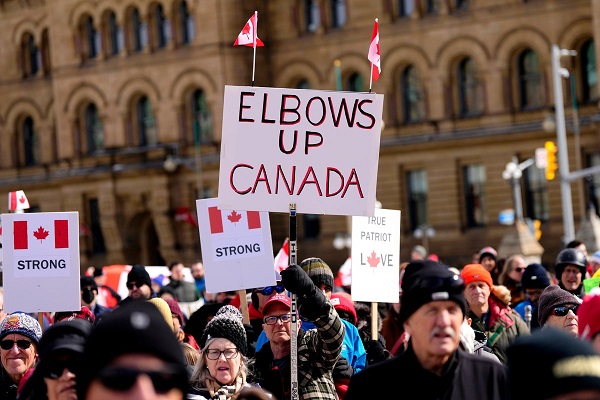Fraser Institute
Dearth of medical resources harms Canadian patients

From the Fraser Institute
The imbalance between high spending and poor access to doctors, hospital beds and vital imaging technology, coupled with untimely access to services, can, and does, have a detrimental impact on patients.
Whether it’s a lack of family physicians or other health-care workers, Canadians know we have a serious health-care labour shortage on our hands. The implications of this shortage aren’t lost on patients (including Ellie O’Brien) who’ve possibly faced delays in accessing organ transplants because potential donors need a regular family doctor to screen them to begin the transplant process.
Given these access issues, coupled with some of the longest recorded wait times for medical procedures on record, is it any wonder that Canadians are dissatisfied with how their provincial governments handle health care?
While one instinct might be to demand governments spend more on health care, it’s not clear we’re getting good value in return for what’s already being spent. In fact, compared to 29 other high-income countries with universal health care, Canada spent the most on health care as a share of the economy at 12.6 per cent in 2021, the latest year of available comparable data (after adjusting for differences in the age structure of each country’s population).
But what do we get in return for this spending?
As far as medical resources go, not a whole lot. In 2021, Canadians had some of the fewest medical resources in the developed world. Out of 30 high-income countries with universal health care, Canada ranked 28th on physician availability at 2.8 per 1,000 people, far behind countries such as seventh-ranked Switzerland (4.5 physicians per 1,000) and tenth-ranked Australia (at 4.3 physicians per 1,000).
But doctors are just one part of the puzzle. Canada also ranked low on available hospital beds (23rd of 29 countries), meaning patients often face delays for hospital care. It can also mean that patients end up being treated for their illness outside a traditional patient room—such as a hospital hallway, a phenomenon that has spread to many provinces.
We also see a low availability of other key medical resources including diagnostic equipment. In 2019, Canada ranked 25th of 29 comparable countries with universal health care on the number of MRIs (10.3 units per million people) compared to top-ranked Japan, which had four times as many MRIs as Canada. And we ranked 26th out of 30 countries on CT scanners (14.9 scanners per million people) compared to second-ranked Australia, which had five times as many CT scanners. It’s also worth noting that a large a portion of Canada’s diagnostic machines are remarkably old.
It’s no accident that countries such as Australia, which actually spend less of its economy on health care compared to Canada, perform better than Canada on measures of resource availability and timeliness of care. Unlike Canada, Australia embraces its private sector as an integral part of its universal health-care system. With 41 per cent of all hospital care in Australia occurring in private hospitals in 2021/22, private hospitals can act as a pressure valve for the entire system, particularly in times of crisis. Indeed, the country outperforms Canada on measures of timely access to family doctor appointments, specialist care and non-emergency surgery, and has done so regularly for years.
The imbalance between high spending and poor access to doctors, hospital beds and vital imaging technology, coupled with untimely access to services, can, and does, have a detrimental impact on patients. For some, this problem can be life threatening. Without genuine reform based on real world lessons from higher performing universal health-care countries including Australia, it’s impossible to reasonably expect our health-care system to improve despite its hefty price tag.
Author:
Automotive
Federal government should swiftly axe foolish EV mandate

From the Fraser Institute
Two recent events exemplify the fundamental irrationality that is Canada’s electric vehicle (EV) policy.
First, the Carney government re-committed to Justin Trudeau’s EV transition mandate that by 2035 all (that’s 100 per cent) of new car sales in Canada consist of “zero emission vehicles” including battery EVs, plug-in hybrid EVs and fuel-cell powered vehicles (which are virtually non-existent in today’s market). This policy has been a foolish idea since inception. The mass of car-buyers in Canada showed little desire to buy them in 2022, when the government announced the plan, and they still don’t want them.
Second, President Trump’s “Big Beautiful” budget bill has slashed taxpayer subsidies for buying new and used EVs, ended federal support for EV charging stations, and limited the ability of states to use fuel standards to force EVs onto the sales lot. Of course, Canada should not craft policy to simply match U.S. policy, but in light of policy changes south of the border Canadian policymakers would be wise to give their own EV policies a rethink.
And in this case, a rethink—that is, scrapping Ottawa’s mandate—would only benefit most Canadians. Indeed, most Canadians disapprove of the mandate; most do not want to buy EVs; most can’t afford to buy EVs (which are more expensive than traditional internal combustion vehicles and more expensive to insure and repair); and if they do manage to swing the cost of an EV, most will likely find it difficult to find public charging stations.
Also, consider this. Globally, the mining sector likely lacks the ability to keep up with the supply of metals needed to produce EVs and satisfy government mandates like we have in Canada, potentially further driving up production costs and ultimately sticker prices.
Finally, if you’re worried about losing the climate and environmental benefits of an EV transition, you should, well, not worry that much. The benefits of vehicle electrification for climate/environmental risk reduction have been oversold. In some circumstances EVs can help reduce GHG emissions—in others, they can make them worse. It depends on the fuel used to generate electricity used to charge them. And EVs have environmental negatives of their own—their fancy tires cause a lot of fine particulate pollution, one of the more harmful types of air pollution that can affect our health. And when they burst into flames (which they do with disturbing regularity) they spew toxic metals and plastics into the air with abandon.
So, to sum up in point form. Prime Minister Carney’s government has re-upped its commitment to the Trudeau-era 2035 EV mandate even while Canadians have shown for years that most don’t want to buy them. EVs don’t provide meaningful environmental benefits. They represent the worst of public policy (picking winning or losing technologies in mass markets). They are unjust (tax-robbing people who can’t afford them to subsidize those who can). And taxpayer-funded “investments” in EVs and EV-battery technology will likely be wasted in light of the diminishing U.S. market for Canadian EV tech.
If ever there was a policy so justifiably axed on its failed merits, it’s Ottawa’s EV mandate. Hopefully, the pragmatists we’ve heard much about since Carney’s election victory will acknowledge EV reality.
Fraser Institute
Before Trudeau average annual immigration was 617,800. Under Trudeau number skyrocketted to 1.4 million from 2016 to 2024

From the Fraser Institute
By Jock Finlayson and Steven Globerman
From 2000 to 2015, annual immigration averaged 617,800 immigrants, compared to a more than doubling to 1.4 million annually from 2016 to
2024 (excluding 2020), according to a new study published by the Fraser Institute, an independent non-partisan Canadian think-tank.
“Over the past decade, Canada’s immigration numbers have skyrocketed, most starkly since 2021,” said Jock Finlayson, senior fellow at the Fraser Institute and co-author of Canada’s Changing Immigration Patterns, 2000–2024.
The study finds from 2000 to 2015, immigration (including temporary foreign workers and international students) grew on average by 3.5 per cent per year. However, from 2016 to 2024 (excluding 2020) immigration grew annually at 21.3 per cent—more than six times the 2000-2015 pace.
The sharp rise in recent years reflects both planned increases in permanent immigrant inflows as well as unprecedented and largely unplanned growth in the numbers of temporary foreign workers, international students, and asylum seekers. For example, in 2024 alone, 485,600 permanent immigrants entered Canada, along with 518,200 international students and nearly one million (912,900) temporary foreign workers.
However, due to concerns about the impact of unprecedented in-migration on housing affordability, employment opportunities (or lack thereof), access to health care and other issues, late last year the federal government unveiled plans to substantially reduce immigration levels over the 2025-27 period, affecting permanent immigrants, international students, and other temporary visa holders.
The composition of immigration also changed dramatically during this period. From 2000 to 2015, the average share of total immigrants in the permanent category was 42.1 per cent while the non-permanent share (mainly international students and temporary workers) was 57.9 per cent. From 2016 to 2024 (excluding Covid 2020), permanent immigrants averaged 27.7 per cent of total in-migration versus 72.3 per cent for non-permanent.
“We’re in the midst of a housing crisis in Canada, and the unfortunate truth is we lack the necessary infrastructure to accommodate immigration at the 2022-24 rate,” said Steven Globerman, senior fellow at the Fraser Institute and study co-author.
“While the reductions announced late last year have been confirmed by the new government, the levels of immigration over the next two year will still be well above historic benchmarks.”
This study is the first in a series of papers from the authors on immigration.

Canada’s Changing Immigration Patterns, 2000—2024
- Immigration, after 2000 and especially after 2015, is characterized by substantial increases in the absolute number of immigrants admitted, as well the share admitted as temporary foreign workers and international students.
- For example, from 2000 to 2015, the total number of immigrants increased at a simple average annual rate of 4% compared to 15% from 2016 to 2024. As well, permanent admissions as a share of total admissions declined by .83 percentage points per year from 2000 to 2015 and by 1.1 percentage points per year from 2016 to 2024.
- These recent developments reflect changes in government policy. In particular, the International Mobility Program (IMP) of 2014 enabled Canadian employers to bring in greater numbers of temporary workers from abroad to fill lower-paying jobs.
- The Advisory Council on Economic Growth appointed by the Trudeau government in early 2016 recommended substantial increases in permanent immigration, as well as in the number of international students who would become eligible for permanent status after acquiring Canadian educational credentials. The Trudeau government enthusiastically embraced the recommendation.
- Recent immigrants to Canada seem better equipped to participate in the labour market than earlier cohorts. For example, over the period from 2011 to 2021, the percentage of established immigrants with a bachelor’s degree or higher increased, and the vast majority of admitted immigrants speak at least one of the official languages. Moreover, recent immigrants enjoy higher employment rates than did earlier cohorts.
- Nevertheless, public concern about the impact of increased immigration—primarily on the affordability of housing—has led the federal government to reduce planned levels of future immigration substantially.

Steven Globerman
-

 International2 days ago
International2 days agoChicago suburb purchases childhood home of Pope Leo XIV
-

 Daily Caller2 days ago
Daily Caller2 days agoBlackouts Coming If America Continues With Biden-Era Green Frenzy, Trump Admin Warns
-

 Daily Caller2 days ago
Daily Caller2 days ago‘I Know How These People Operate’: Fmr CIA Officer Calls BS On FBI’s New Epstein Intel
-

 Alberta11 hours ago
Alberta11 hours ago‘Far too serious for such uninformed, careless journalism’: Complaint filed against Globe and Mail article challenging Alberta’s gender surgery law
-

 Frontier Centre for Public Policy1 day ago
Frontier Centre for Public Policy1 day agoNew Book Warns The Decline In Marriage Comes At A High Cost
-

 Economy1 day ago
Economy1 day agoThe stars are aligning for a new pipeline to the West Coast
-

 National1 day ago
National1 day agoLiberal ‘Project Fear’ A Longer Con
-

 Censorship Industrial Complex22 hours ago
Censorship Industrial Complex22 hours agoCanadian pro-freedom group sounds alarm over Liberal plans to revive internet censorship bill








